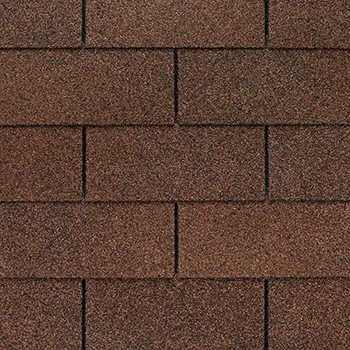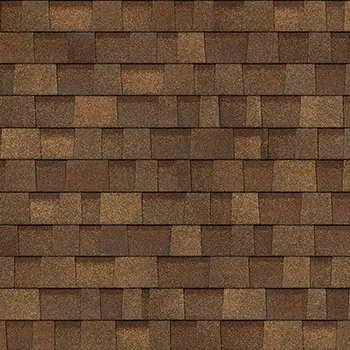Today, there are a wide variety of roofing materials. When discussing residential roofing, we often hear about asphalt shingles, but what are they?
Asphalt shingles are a type of roof covering that uses asphalt for waterproofing. Each shingle is flat and rectangular, measuring 1′ tall and 3′ wide. The shingles overlap and seal to each other to cover a roof. Asphalt shingles are the most popular residential roofing system, compared to tile or metal.
Granules on the roofing shingles block ultraviolet light (UV) from the sun and protect the asphalt underlayment. As shingles age, the granules fall off. As a result, the shingle dries out and gets a “potato chip” appearance as the corners start to curl up. Shingles appear to bubble at the extreme end of their life and become brittle.
Your basic 3-tab shingles have an average lifespan of around 20 years. Architectural or dimensional shingles, on the other hand, last on average between 25 and 30 years.
Learn more about the differences between asphalt shingles, tile and metal, including the pros and cons of each, average costs and more in our Guide to Residential Roofing.



Owens Corning’s 3-tab shingles starts with a bottom layer of asphalt. (Asphalt is a mixture of pitch with sand or gravel.) Next is the fiberglass mat. (an organic mat is no longer available) This fiberglass mat provides strength and durability. On top of the fiberglass mat is another layer of asphalt. The fourth layer is the colorful granules that give your roof style and protection from water and ultraviolet (UV) rays. The top layer is a sealant that also helps keep water out.
What are the Benefits of Asphalt Shingles?
✅ Variety of Colors
✅ Shapes and Textures
✅ Quick and Easy Installation
✅ Affordable
✅ Versatile
✅ Impact Resistant
✅ Fire Resistant
✅ Mold Resistant
✅ Wind Resistant
✅ Releasing Heat
❌ Recyclability
❌ Reflecting Heat
❌ Longevity
Wide Variety of Colors
Owens Corning most popular shingle, TruDefinition© Duration©, comes in 13 different colors, alone. There are various browns, greens, grays, blues, blacks, whites, and reds. If you’re wanting something light to help reflect heat away from your home, there’s Shasta White. Or maybe you’re the bold type and want something dark, such as Onyx Black. Maybe you want something more natural, such as Chateau Green or Brownwood. Whatever color the outside of your house is, there’s a shingle color that will look great.
Shapes and Textures
Today’s asphalt shingles come in different shape and styles. Your basic 3-tab, non-dimensional shingles appear flat and resemble subway tile. There are several architectural or dimensional shingles that can resemble natural wood shake or slate.
Easy Installation
Asphalt shingles are relatively easy to install. Each shingle is relatively lightweight. Roofing nails are used along with a nail gun to secure each shingle to the roof deck. Some manufacturers, such as Owens Corning, have created a nailing line to follow on each shingle, which makes the installation process go even faster. A utility knife is used to cut asphalt shingles.
Affordable
Initially, aside from modified bitumen, asphalt shingles are the least expensive residential roofing option today. For a 2500 square foot roof, expect to pay around $8500 ($3.40/sqft) for your average, mid-grade architectural asphalt shingles. Actual prices depends upon exact shingles installed, condition and difficulty of existing roof, and more.
Versatile
Because asphalt shingles are made of asphalt and fiberglass, they are flexible. This means they can be installed onto curved roofs. They can also be easily cut with a utility knife to fit different shapes. Because they come in a wide variety of colors, you can easily find an asphalt shingle that matches the color of your house or small office.
Impact Resistant
Living in Colorado means hail, sometimes large hail. It’s not unusual to have multiple hail storms that carry large hail stones in a single year. Every asphalt shingle manufacture we carry, offers at least one Class 4 impact resistant shingle. Impact resistance ranges on a scale from 1 to 4, 4 being the highest.
Fire Resistant
Although asphalt shingles are not fire-proof, they are fire-resistant. This is partly due to the fiberglass mat. Having asphalt in them doesn’t necessarily mean they are a fire hazard. Fire ratings are on a scale from Class C to Class A, Class A being the highest or best to resistant fire. Every asphalt shingles we carry of Owens Corning is Class A fire rated.
Algae Resistant
Here in Colorado, with our relatively low humidity, we don’t normally have to worry about algae growth, since algae usually only grows in humid parts of the country. That said, there can be humid areas on your roof, such as under leaves and pine needles that are left on your roof for long periods of time. Owens Corning shingles with StreakGuard™ helps inhibit the growth of algae. GAF’s shingles with StainGuard Plus™ also helps to prevent algae growth.
Wind Resistant
Even your basic 3-tab shingle is wind resistant, up to 60 mph. When you get into the architectural/dimensional shingles, those are often resistant to winds in excess of 110 mph.
Releasing Heat
Our research shows asphalt shingles ranked among the highest at releasing trapped heat once warmed by the sun. This is known as thermal emittance.
Disadvantages of Asphalt Shingles
Reflecting Heat
Asphalt shingles are among the worst at reflecting heat from the sun. In fact, most shingles barely meet the minimum Energy Star Rated rating of .25 and .15 after 3 years.
Recyclability
In our area, asphalt shingles are not recyclable.
Longevity
Asphalt shingles don’t last that long. 3-tab/strip shingles only last 10-15 years. Even luxury/designer shingles don’t last very long, at only 15-25 years. If you’re interested in a shingle that lasts a long time, consider stone-coated steel shingles.
Who Should Use Asphalt Shingles?
Roofing shingles are for any building that has a steep-slope (or non-low-slope) roof. Most homes and other residential buildings, and small offices have shingles, primarily because they are affordable, easy to install, and you can color-coordinate the shingles to match the house or building color. Asphalt shingles are also great for those on a budget as they’re the least expensive initially. (if you’re looking for a roof that’s low-cost long-term, consider stone-coated steel shingles.)
Feel free to contact us if you have any questions regarding asphalt shingles, or if you would like an estimate or a free roof inspection.
